Red-Eared Slider
Trachemys scripta elegans
Sliders spend lots of time basking in the sun. As cold-blooded animals, they need the sun to heat up.
Advertisement
Red-Eared Slider Scientific Classification
- Kingdom
- Animalia
- Phylum
- Chordata
- Class
- Reptilia
- Order
- Testudines
- Family
- Emydidae
- Genus
- Trachemys
- Scientific Name
- Trachemys scripta elegans
Read our Complete Guide to Classification of Animals.
Red-Eared Slider Conservation Status
Red-Eared Slider Facts
- Prey
- Insects and their larvae, spiders, crawfish, freshwater clams and sponges, eggs, snails, fish, slugs, small amphibians and reptiles
- Name Of Young
- hatchling
- Group Behavior
- Solitary
- Fun Fact
- Sliders spend lots of time basking in the sun. As cold-blooded animals, they need the sun to heat up.
- Estimated Population Size
- millions
- Biggest Threat
- none
- Most Distinctive Feature
- The red stripe behind its ear
- Other Name(s)
- none
- Gestation Period
- 60 to 95 days
- Litter Size
- Two to 20 eggs
- Habitat
- In forests or savannas near freshwater bodies. The water needs to be shallow, sluggish and full of plant and animal life and places for the turtle to bask.
- Predators
- Snakes, alligators, waterbirds, crows, opossums, large fish, skunks, raccoons, minks, otters, foxes, armadillos, coyotes and humans. White tailed deer and foxes eat their eggs.
- Diet
- Omnivore
- Type
- reptile
- Common Name
- Red-eared slider
View all of the Red-Eared Slider images!
“The red-eared slider is the pet turtle to the World”
Chances are you’ve had one of these pretty turtles with the red streak behind its eyes when you were a child. If it was well-cared for, it’s possible that you still have it as a grown-up. Hardy and prolific, the red-eared slider is kept as a pet turtle just about everywhere. Some have also escaped and are now living in freshwater lakes and ponds just about everywhere. Here is more information about this remarkable reptile.

Four Incredible Red-Eared Slider Facts!
Here are four amazing facts to know about T. scripta elegans:
- It is the most popular type of pet turtle on earth as well as the most invasive.
- It is a subspecies of Trachemys scripta, the pond slider.
- Sliders are good at tolerating cold temperatures. They don’t hibernate but brumate, often underwater.
- Baby turtles stay in their eggshell for a few days after hatching.

The red-eared slider is a subspecies of the pond slider.
©effective stock photos/Shutterstock.com
Scientific Name
The red-eared slider’s scientific name is Trachemys scripta elegans, which means it is a subspecies of the turtle Trachemys scripta. Trachemys comes from the Greek words for “roughness” which is trachys and “turtle” which is emys. Scripta is Latin for “writing” and describes the swirls of green and yellow colors on the turtle’s skin and shell. Elegans is also Latin and means “elegant.”
Species
The red-eared slider is one of three subspecies of the pond slider (Trachemys scripta). The other two subspecies are the yellow-bellied slider (T.s. scipta), and the Cumberland slider (T.s. troostii).
Evolution

Tortoises evolved in South
Africa
, from a small reptile named
Eunotosaurus africanusaround 260 million years ago.
Tortoises and turtles evolved in South Africa, from a small reptile named Eunotosaurus africanus around 260 million years ago. This strange little lizard had the makings of modern-day turtles with thick, backward curving ribs that formed an armored dome under its skin.
A reptile called Odontochelys semitestacea, evolved 40 million years later in the shallow oceans of China. The Odontochelys had one trait that modern turtles and tortoises share – a plastron or bottom shell. It is believed that these turtle ancestors developed lower shells first because sharks and other predators attacked them from below the surface of the water.
Proganochelys, or “beast turtle” lived among dinosaurs and was armored above and below. In addition to its protective shell, this ancient turtle had bony neck spikes, leg spikes, and tail spikes. Like its modern relatives, it had a bony shell and a toothless mouth.
These three turtle ancestors diverged into the terrapin, sea turtle, and tortoise we know today.
Appearance

©iStock.com/PaulReevesPhotography
Identification of the red-eared slider is easy, for this turtle is everywhere and no other turtle in America has the red streak behind the eye. Though it is native to the southern part of North America, biologists believe at least 50 million are kept as pets all over the world.
It is a small turtle that rarely grows over 12 inches long or weighs much more than half a pound. Its shell is divided into the upper part, which is the carapace, and the lower, which is the plastron. These elements are covered in scutes, or bone covered with keratin. The scutes on the carapace are green, and the plastron is light yellow with green, squiggly markings.
The legs, head, and tail of the turtle are green with beautiful yellow stripes and markings. It has webbed feet with claws, and the male’s claws are notably longer. This helps in the identification of the male turtle. Of course, there’s that bright red band behind the turtle’s eye that gives it its common name.
Behavior
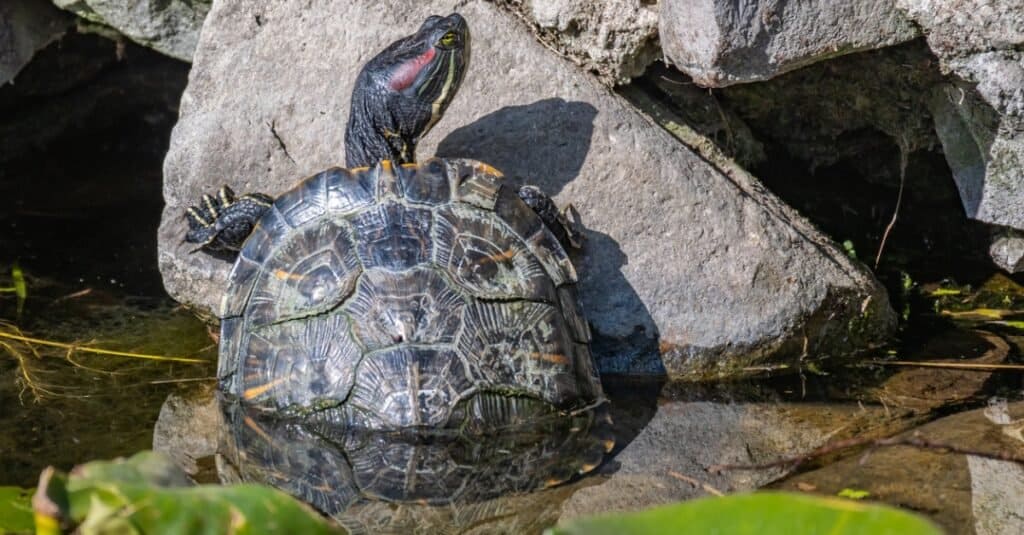
Red-eared sliders are not aggressive and like to congregate with their fellow turtles to bask in the sun.
©iStock.com/MriyaWildlife
These freshwater turtles are gregarious and often congregate on rocks or logs to bask in the sun, something they need to do to regulate their body temperature. When they sense danger, they slide en masse into the water, which gives them their name of “slider.” When they’re not basking, they’re swimming and looking for food. The turtles also feed on both plants and animals on land. They do not appear to stake out territories nor are they particularly aggressive – which is one reason why red-eared sliders make good pets.
The turtles depend largely on their sense of sight to communicate, and roll and flick their eyes to do so. They also use their front claws to create vibrations in the water or to touch their fellow sliders.
Habitat
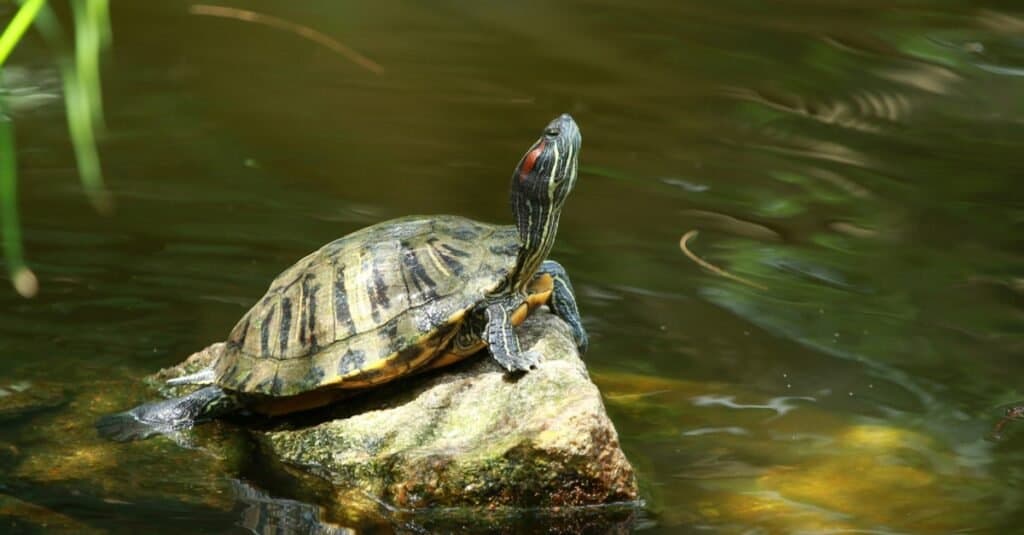
Red-eared sliders are semi-aquatic and prefer shallow, slow-moving ponds, creeks, and swamps.
©dawi88888/Shutterstock.com
Red-eared sliders are semi-aquatic animals, so they need to live near fresh or brackish water found in savannas or forests. They can be found in calm rivers, ponds, streams, creeks, swamps, lagoons, and even impermanent, man-made farm ponds. They prefer the water to be slow-moving and no deeper than three feet.
Though the turtle is native to the area around the Gulf of Mexico and the Mississippi River, it has been introduced in many other locations worldwide. There are now populations of red-eared sliders in the Blue Ridge Mountains, California, Hawaii, New Jersey, Pennsylvania, and other states. It is now found in Canada, Mexico, Africa, Australia, Israel, southern Europe, the Netherlands, Japan, China, Indonesia, and other Asian countries. Scientists believe the turtle is as successful as it is due to its ability to tolerate cold and its unfussy diet.
Diet

Red-eared sliders are considered opportunistic omnivores and will eat just about anything that appeals to them. Because they need a lot of animal protein, baby turtles are almost exclusively carnivorous, and they won’t thrive if they can only eat plant material. To this end, young turtles eat beetles, spiders, insect larvae, snails, slugs, and aquatic life. They’ll even eat carrion.
They become omnivorous as they grow and their digestive system can handle a diet that includes different types of plants. The turtle mostly eats aquatic plants such as duckweed and algae. They will eat the flowers, seeds, stems, and leaves of more complex plants. Adult turtles will also continue to eat animals that they can handle, including mollusks, small amphibians, insects, and other arthropods.
Predators and Threats
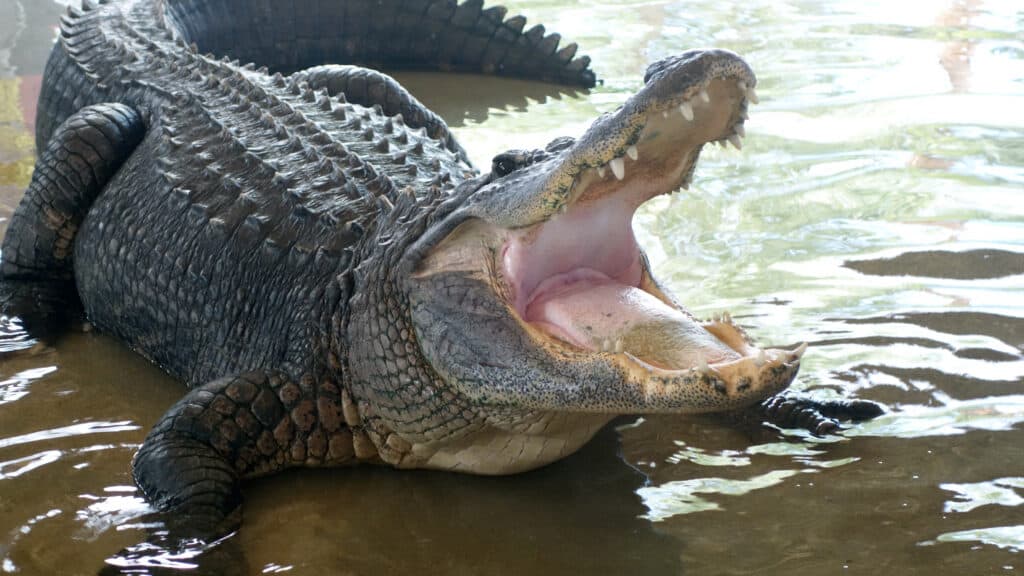
Having a protective shell doesn’t help the red-eared slider when preyed upon by an alligator – they just swallow it whole.
©Ernie Hounshell/Shutterstock.com
Having a shell covered with scutes helps avoid predation, as is having that shell flash colors that hint that the animal might be poisonous. Though some turtles have survived attacks from predators as robust as alligators, the red-eared slider is part of the diet of many carnivores, including humans. Still, T. scripta elegans is a favorite of predators from alligators to snakes, which don’t bother to crush their shells but swallow them whole. Other turtle-eating creatures are coyotes, foxes, armadillos, mustelids, skunks, and wading birds. White-tail deer, which are supposed to be herbivores, eat the eggs. The turtle is not only a delicacy in some parts of the world but people frequently run over it with boats and cars and just shoot them for fun as they bask on logs.
Besides predators, turtles are hosts to a range of parasites including leaches, flukes, and roundworms. They are also notorious vectors of the salmonella bacteria that cause illness, sometimes serious illness, in humans.
Reproduction and Life Cycle
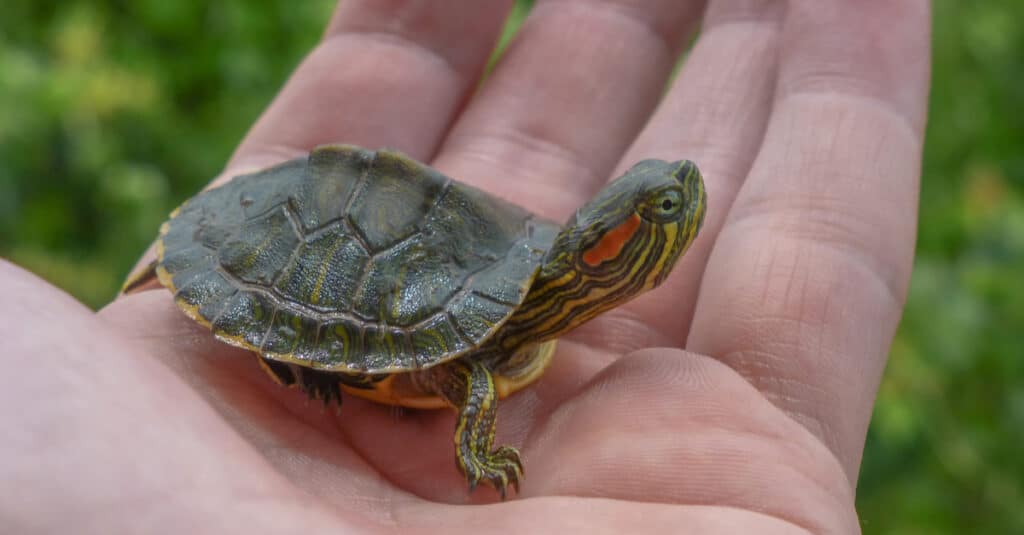
Baby red-eared sliders aren’t ready to enter the water until three weeks after hatching.
©iStock.com/Funkuokando Nin
The turtle is ready to breed when the male is about two to five years old and the female is about five to eight years old. It has interesting courtship displays, including the male using his long front claws to make enticing vibrations in the water in front of the female. He may also use his claws to touch her face, and she may do the same to him. Younger males may dispense with rituals altogether and simply, as they say, have at it.
When the eggs are laid depends on the female. She can store sperm in her body until she’s ready, for she may need to eat or bask more than usual to make sure the eggs are healthy. Her eggs are fertilized when they are laid.
Red-eared sliders breed from April to the end of October, and a female can lay as many as four clutches of two to 20 eggs per clutch. The female prepares a nest using her hind legs and prefers a spot that gets plenty of suns. To find that place she may travel as much as 0.99 of a mile from where she usually lives.
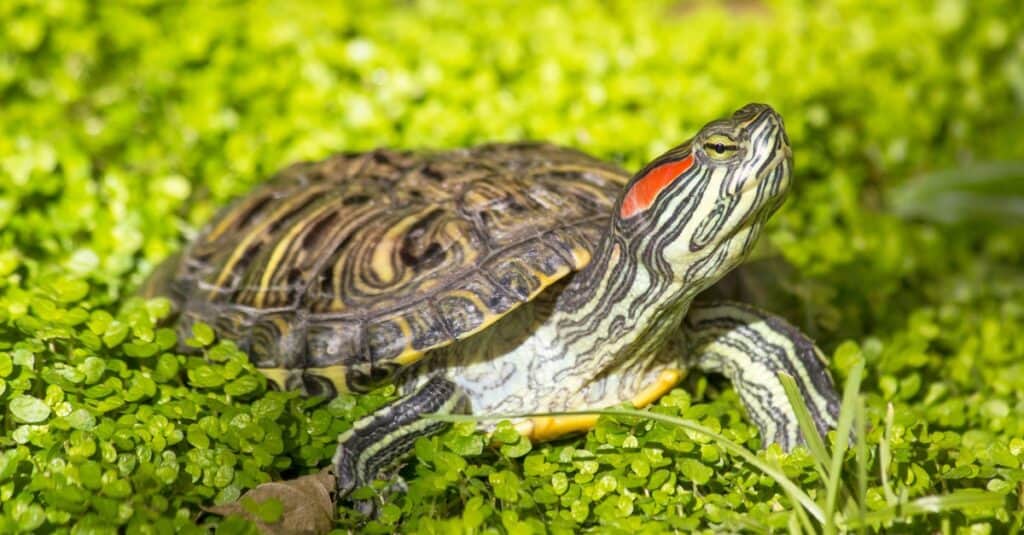
Female red-eared sliders must find the perfect, sunny spot to build a nest and lay her eggs.
©xbrchx/Shutterstock.com
The nests are built at night or when it’s raining, and the female digs until the hole is about 3.93 to 5.5 inches deep. She’ll then deposit the eggs and leave. The eggs will hatch between 59 and 112 days. The time is lessened if they are in a warm and sunny spot. It’s important that the eggs not be disturbed, for turning an egg over can cause the embryo inside to suffocate.
The baby turtle breaks out of its egg with an egg tooth that falls off after an hour, but it can spend a couple of days in its eggshells. During this time the baby still has a yolk sac attached to its plastron. This sac, which provides nourishment, needs to be absorbed, and the place where it was attached needs to heal before the turtle can enter the water. The hatchling is old enough to enter the water when it’s about three weeks old.
Turtles are famous for their long lifespans, and the red-eared slider is no exception. Its lifespan is about 30 years, and it may live as long as 40. It doesn’t live as long in captivity, however.

There are so many millions of red-eared sliders in the world that they have become invasive in many places.
©iStock.com/slowmotiongli
Population
There are tens of millions of these turtles in the world. As of 2016, the population in Japan alone was eight million individuals, and they were squeezing out the turtle species that were native to Japan. The turtle’s conservation status is not merely the least concern, but it is invasive in many places.
View all 114 animals that start with RRed-Eared Slider FAQs (Frequently Asked Questions)
Are red-eared sliders carnivores, herbivores, or omnivores?
Red-eared sliders are omnivores.
What do red-eared slider turtles eat?
As omnivores, red-eared sliders eat both plant and animal material.
How long do red-eared slider turtles live?
The lifespan of this turtle is about 30 years.
How do I take care of a red-eared slider?
Red-eared sliders have a reputation for being easy to care for, but they do need more care than people think. They need a surprisingly large tank size that provides them with fresh water to swim in, ultraviolet B lighting that needs to be on for at least half a day, and places to bask. Though the price of a single pet turtle may be low, the price of making sure it stays healthy may be high. The owner also needs to make sure that the habitat is kept clean, and the turtle has a balanced diet.
How big do red-eared slider turtles get?
These turtles can grow to long as 12 inches. This should be taken into account when considering tank size.
Why is it illegal to have a red-eared slider?
It is illegal to own this turtle in some places because people either release them, or they escape into the wild. Once there, they outbreed the native turtle population and unbalance the ecosystem.
Is a red-eared slider a good pet?
If it is well cared for, the red-eared slider is a very good pet. It is a beautiful, long-lived animal, and some people say they have their own personalities. The price of one of these turtles is also low.
Do red-eared sliders like to be held?
Like a lot of reptiles, these turtles don’t like to be held very much. Pick up your turtle only when it’s necessary.
Do red-eared sliders need to be in the water all the time?
They do not need to be in the water all the time. Indeed, they should not be in the water all the time. The tank size should be roomy enough to have places where they can come out to bask and eat.
Can red-eared sliders go outside?
These turtles can be raised outside if the owner can provide them with the right habitat. The price of providing this might be prohibitive for some people.
Is there a difference between male and female red-eared sliders?
Male vs female red-eared sliders main physical differences are in size and tail length and placement
What are the differences between red-eared sliders and painted turtles?
The key differences between red-eared sliders and painted turtles can be found in their location as well as size.
Thank you for reading! Have some feedback for us? Contact the AZ Animals editorial team.
Sources
- The Physics Factbook / Accessed January 24, 2022
- Wikipedia / Accessed January 24, 2022
- CABI / Accessed January 24, 2022
- Virginia Herpetological Society / Accessed January 24, 2022
- USGS / Accessed January 24, 2022
- thejapantimes / Accessed January 24, 2022
- Everything Reptiles / Accessed January 24, 2022
- thesprucePets / Accessed January 24, 2022


















